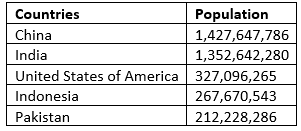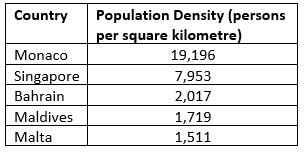Population Dynamics Chapter Notes | Science for Grade 7 PDF Download
| Table of contents |

|
| Introduction |

|
| World Population |

|
| Overpopulation and Underpopulation |

|
| Population Composition |

|
| Population Pyramid |

|
Introduction
Population dynamics refers to the study of how and why populations change over time. It involves examining various aspects such as:
- Population size
- Growth
- Distribution
Additionally, population dynamics explores how these factors impact economic, social, and environmental systems. By understanding these changes, we can make predictions about future trends and their implications for essential resources like air, land, and water.
This chapter covers the key aspects of population, including its growth, distribution, density, and the factors influencing these changes.
World Population
- The global population has seen a remarkable increase over the past 200 years, growing from less than one billion in 1900 to over seven billion today.
- A significant portion of the world's population resides in developing countries.
- Population distribution is uneven, with some areas being sparsely populated while others are densely populated.
- Although the rate of population growth has slowed down recently, future trends remain uncertain.
- Improved healthcare could lead to lower death rates, potentially increasing the population.
- On the other hand, diseases and conflicts can cause a decrease in population in certain areas.
- Understanding changes in population is essential, as they have significant impacts on social, economic, and cultural aspects.
Distribution of Population in the World
- Population distribution shows where people live on Earth, often represented through maps indicating population density.
- Population density measures the number of people living in a square kilometre.
- Areas with low population density, such as mountains or deserts, present challenging living conditions.
- In contrast, regions with high population density, like Europe and Southeast Asia, provide more suitable living environments.
- Three major densely populated regions are East Asia, South Asia, and Europe, all linked to ancient civilisations.
- Approximately 90% of the world’s population lives in the Northern Hemisphere.
- East Asia, including China, Korea, and Japan, accounts for about a quarter of the global population, with China alone having around 1.4 billion people.
- South Asia, comprising India, Pakistan, Bangladesh, and Sri Lanka, has around 1.5 billion people and is experiencing rapid growth, exceeding the region’s capacity to support its population. It is one of the most densely populated areas in the world.
- Most people in South Asia are engaged in primary economic activities, such as agriculture.
- Europe has a population of about 700 million, primarily living in urban areas, unlike the more rural populations in East and South Asia, a shift that began during the Industrial Revolution over two hundred years ago.
Population Density
- Population density measures the average number of individuals living per square kilometre.
- It reflects how the population is distributed and varies based on the size of the area.
- Formula: Population density = Total population / Total land area in km².
- Areas are classified into three density categories:
- Low density: Fewer than 10 people per square kilometre (e.g., Sahara Desert, Canada).
- Medium density: 10-50 people per square kilometre (e.g., California, Southeast Australia, Nile Valley in Egypt).
- High density: More than 50 people per square kilometre (e.g., South Asia, Europe).
Factors Responsible for Population Growth
The growth of population depends on a number of factors. These factors can be broadly grouped into three major categories:
- Physical factors
- Economic factors
- Social and cultural factors
Physical Factors
1. Landforms
- Flat Areas: Regions with flat terrain, such as the Gangetic Plains in India, tend to have a high population density. These areas are more accessible and suitable for settlement.
- Mountainous Regions: In contrast, mountainous areas like the Himalayas are less populated due to their challenging terrain, including steep slopes and high altitudes, which make habitation difficult.
2. Climate
- People are generally drawn to regions with moderate climates and tend to avoid extreme environments. For example, harsh climates like those found in the Sahara Desert or the polar regions are less attractive for settlement.
3. Soil Fertility
- Fertile soils, particularly in river valleys such as the Ganga, Brahmaputra, Huang He, Chang Jiang, and Nile, support agriculture and attract larger populations. These fertile areas provide the necessary resources for farming, which is a primary means of sustenance.
4. Water Availability
- Access to fresh water is a critical factor for population density. Regions with abundant water supply, such as river valleys, are densely populated, while arid areas like deserts have lower populations due to the scarcity of water.
Economic Factors
1. Mineral Wealth
- Areas rich in minerals attract industries and mining activities, leading to an influx of skilled and semi-skilled workers seeking job opportunities. For instance, the Katanga Copperbelt Province in the Democratic Republic of the Congo has a significant population due to the availability of mining jobs.
2. Urbanization
- Urban areas draw people from rural regions and other countries due to better job prospects, education, healthcare, transportation, and other amenities. Major cities around the world experience significant population growth as they attract migrants seeking improved living conditions.
3. Industrialization
- Industrial regions provide a wide range of job opportunities, attracting not only factory workers but also various service providers such as transport operators, shopkeepers, bank staff, doctors, and teachers. For example, the Kobe-Osaka region in Japan is densely populated due to its industrial base.
Social and Cultural Factors
1. Social and Political Stability
- Areas experiencing social and political unrest drive people to seek refuge in more stable environments. For instance, individuals fleeing countries like Ethiopia, Syria, and Cyprus due to conflicts or instability are examples of this phenomenon.
- Some governments also incentivize relocation to less populated areas or encourage people to move away from overcrowded regions to balance population distribution.
2. Religious Significance
- Cities with significant religious and cultural importance attract people due to their spiritual value. For example, Varanasi in India and Vatican City have high populations because of their religious significance and the influx of pilgrims and visitors.
Factors Affecting Population Change
Population change in a country is influenced by three main factors: birth rate, death rate, and migration.
Birth Rate
- Definition. The birth rate refers to the number of live births per 1,000 people in a given year.
- Impact. A high birth rate contributes to an increase in the population, while a low birth rate can lead to a decrease.
Death Rate
- Definition. The death rate is the number of deaths per 1,000 people in a year.
- Impact. A high death rate can reduce the population, often due to factors like disease or lack of proper healthcare.
Migration
- Definition. Migration refers to the movement of people from one place to another, which can increase or decrease the population of the areas involved.
- Emigration. This is when people leave a country, resulting in a decrease in that country's population.
- Immigration. This is when people move into a country, leading to an increase in its population.
- Example. During the Irish famine in the 1840s, those who left Ireland were called emigrants by those who stayed, but were referred to as immigrants by those in America.
Rate of Change
- Natural Increase. This is the difference between the birth rate and the death rate, indicating the natural growth of the population.
- Calculation. Natural increase is calculated by subtracting the death rate from the birth rate.
- Expressing as Percentage. The rate of natural increase is expressed as a percentage by dividing the natural increase by 10.
- Example. If the birth rate is 14 per 1,000 people and the death rate is 8 per 1,000 people, the natural increase is 14 - 8 = 6, which translates to 6/10 = 0.6%.
Overpopulation and Underpopulation
Countries experience either overpopulation or underpopulation depending on their ability to support the population with available resources.
- Overpopulation occurs when a country’s resources are insufficient to support its population, leading to issues such as unemployment, pollution, and environmental degradation.
- Essential resources like food, shelter, clean water, fuel, and farmland become scarce.
- Developing countries often experience rapid population growth, while developed nations typically have stable or declining populations.
- In 1950, the global population was predominantly younger, but by 2017, there was a significant increase in the elderly population, with a projected balance by 2050.
- Most Populated Countries (2018): China (1.43 billion), India (1.35 billion), USA (327 million), Indonesia (268 million), Pakistan (212 million).
- Countries with Highest Population Density (2018): Monaco (19,196 per km²), Singapore (7,953 per km²), Bahrain (2,017 per km²), Maldives (1,719 per km²), Malta (1,511 per km²).

Population Dynamics
Overpopulation and underpopulation are influenced by the concepts of carrying capacity and population balance, which are crucial for understanding how populations change over time.
Reasons for Overpopulation
- Migration: People move to richer countries or cities in search of better job opportunities, leading to urban expansion, homelessness, overcrowding, and a rise in crime rates.
- Illiteracy:. lack of education results in insufficient knowledge about family planning, contributing to population growth.
- Poverty: Families with limited resources often have more children to help support the household, which exacerbates poverty and hinders children's education.
- Birth and death rates: Advances in healthcare and medical technology increase birth rates and decrease death rates, further contributing to population growth

Consequences of Overpopulation
- Depletion of Resources: Overpopulation leads to the rapid depletion of essential natural resources such as food and water. The increased demand from a growing population puts immense pressure on these finite resources, making them scarce.
- Environmental Degradation: The environmental impact of overpopulation is significant, contributing to issues like deforestation, habitat loss, pollution, and global warming. As more land is needed for housing, agriculture, and industry, natural habitats are destroyed, and pollution levels rise due to increased industrial activity.
- Economic Strain: Overpopulation can strain the economy, leading to a lack of job opportunities. When the population grows faster than the economy can create jobs, unemployment rises, and economic stability is threatened.
- Poor Health and Sanitation: Overpopulation often results in poor health, sanitation, and hygiene conditions. The excessive use of land and inadequate infrastructure to support a large population can lead to unsanitary living conditions, which negatively impact public health.
Underpopulation
- Underpopulation occurs when a country’s population is too small to utilize its resources effectively.
- Fertility rates in many countries have dropped to about two children per woman due to literacy, economic development, and urbanization.
- Emigration, diseases, and famines cause underpopulation.
Consequences of Underpopulation
- Economic deflation due to low demand.
- Reduced pressure on resources and pollution levels.
- Increased pressure on youth to support the economy, leading to poor quality of life.
- Labour shortages, which can have both positive and negative effects.
Population Composition
Population composition refers to characteristics like occupation, education, life expectancy, age, sex, and place of residence.
Rural-Urban Composition
- Rural populations are higher in agricultural countries, while urban populations dominate in industrialized countries.
- Highly urbanized regions (over 75% urban population) include western and northern Europe, Australia, New Zealand, temperate South America, and North America.
- In developing countries in Asia and Africa, less than one-third of the population is urban, but urban growth is rapid.
- By 2030, about eight billion people are expected to live in cities, with 80% in developing countries.
Literacy Rate

- Literacy plays a crucial role in determining living standards, income levels, and overall development within a society.
- Over the years, global literacy rates have seen significant improvement. However, it's important to compare these figures with data from NCERT (National Council of Educational Research and Training) for a clearer context.
- Despite the progress, 17% of the world's population still remains illiterate, which highlights the ongoing challenges in this area.
- In less affluent countries, low literacy levels hinder their advancement and development. For instance, Niger has a youth literacy rate of only 36.5%, reflecting the struggles in education and literacy.
- Global literacy rates stand at 90% for males and 82.7% for females, indicating the overall capability of individuals worldwide to read and write.
- Regional literacy rates vary significantly, with developed countries boasting a rate of 99.2%, while other regions like Oceania, South and West Asia ( 70.2% ), and sub-Saharan Africa show varying levels of literacy. In India, the overall literacy rate is 74.04%, with states like Kerala leading at 93.91% and Bihar lagging behind at 63.82%.
Sex Composition
- Sex composition refers to the ratio of females to males in a given population, typically expressed as the number of females per 1,000 males.
- Global Trend: Initially, more males are born than females worldwide. However, females generally have a longer life expectancy, which leads to a higher number of females in the population after the age of one.
- Factors Influencing Sex Composition:
- In regions where women are valued less, the mortality rate for females is higher, impacting the sex ratio.
- Immigrant groups and communities facing challenging living conditions often exhibit male dominance.
- Certain populations, such as those in military towns, can show significant imbalances in the sex ratio.
- Urban areas in developing countries typically have a higher number of males compared to females.
- India’s Sex Ratio (2011): In India, the sex ratio was 940 females for every 1,000 males in 2011, an improvement from 933 in 2001. This change is impacted by serious issues such as
- Female Foeticide: The practice of aborting female fetuses due to a preference for male children.
- Gender Discrimination: The unequal treatment of individuals based on their gender, often leading to the neglect and mistreatment of females.
- Female Infanticide: The illegal act of killing newborn female infants, often due to cultural biases favoring males.
- Sex-Selective Abortions: The practice of terminating pregnancies based on the sex of the fetus, usually favoring male children.
- Neglect of Girls: The societal tendency to prioritize the needs and well-being of boys over girls, leading to harmful consequences for female children.
Age Composition
Age composition refers to the distribution of people across different age groups, which significantly impacts resource utilization and the workforce's capacity.
- Age groups:
- Children: 0-14 years (dependent population)
- Working Age: 15-59 years (productive population)
- Old Age: Above 59 years (dependent population)
- As of 2017, the specific percentage figures for these age groups can vary depending on the context and should be verified from the relevant NCERT textbook.
- A large, skilled, educated, and healthy working-age population is crucial for enhancing a nation's economic growth.
Definition of Dependent Population: The dependent population includes individuals who are not part of the workforce, primarily children and the elderly. These groups rely on the working-age population for support and resources.
Population Pyramid
- Population pyramids are visual representations that show the distribution of a population by age and gender. These charts usually have a triangular shape, with males depicted on the left side and females on the right.
- There are four main types of population pyramids:
- Progressive
- Expansive
- Stationary
- Stable or Declining
Progressive Population Pyramid
- A progressive population pyramid is characterized by its triangular shape, with a broad base and a narrow top. This shape indicates high birth and death rates.
- Such pyramids are commonly found in developing countries that face issues like poverty, low levels of female education, and insufficient healthcare.
- In these populations, there is a large number of children, which can create pressure on the working-age group to support them.
- For instance, Niger exemplifies a country with a progressive population pyramid due to its one of the highest birth rates in the world.
Expansive Population Pyramid
- This pyramid is like a progressive pyramid but has a stable base, showing that there are lower death rates among young people.
- It features high birth rates and a longer life expectancy compared to progressive pyramids.
- More individuals are able to reach middle age in this scenario. Example: Nigeria.
Stationary Population Pyramid
- This pyramid has a rectangular or square shape, with similar population sizes across different age groups, decreasing only in the older age brackets.
- It is characterized by high life expectancy, stable birth rates, and improved living conditions.
- There is greater awareness and incentives for family planning, along with equal status for women in society. Examples: Morocco, Germany.
Constrictive Population Pyramid
This part talks about the features of the inverted population pyramid, which is a demographic pattern seen in some countries.
- Narrow base: This shows that there are low birth rates in these countries.
- Wider middle/top: This indicates high life expectancy, meaning people live longer.
- Common in developed countries: These countries have good living conditions and generally fewer births.
- More elderly than youth: There are more older people than young people, which puts a strain on the working-age population.
- Population decline: The population can decrease because of low birth rates and high rates of emigration, where people move away from the country.
Examples: Countries like Australia, Japan, and Germany exhibit this population structure.
|
87 videos|170 docs|69 tests
|
FAQs on Population Dynamics Chapter Notes - Science for Grade 7
| 1. What are the main factors responsible for population growth? |  |
| 2. What is the difference between overpopulation and underpopulation? |  |
| 3. How does population composition affect a country's development? |  |
| 4. What is a population pyramid and what does it represent? |  |
| 5. Why is sex composition important in studying population dynamics? |  |















